The incredible change we’re all experiencing these days is highly fractal. Similar patterns are emerging at many levels, and we can learn a lot by zooming in and zooming out.
For instance, we can talk about how marketing technology is changing — which it is, at a phenomenal pace. But we can also go higher up and examine how marketing overall is changing. We can go even higher up and realize how businesses, industries, and entire economies are being transformed around us.
The engine of this breathtaking change at all levels is technology. And before you dismiss that as obvious — “that’s nothing new, we’ve been dealing with technological change for centuries!” — you absolutely must read The Second Machine Age by Erik Brynjolfsson and Andrew McAfee.
In this New York Times bestseller — which I believe is one of the most important books of 2014 — Erik and Andrew make a strong case for why we’ve reached a truly pivotal inflection point, thanks to a perfect storm of three powerful forces:
- Exponentially improving technology.
- The digitization of everything and the network effects of a connected world.
- Exploding combinatorial possibilities of different innovations that can be remixed in creative new ways.
The First Machine Age was born of the Industrial Revolution — using machines to replace or augment our physical capabilities. The Second Machine Age is about using machines to replace or augment our mental capabilities. While we’ve thought about computers this way for a while, it’s usually been with the caveat that, of course, machines were very good at calculating and following rules — but very bad at “recognizing patterns” and demonstrating other human qualities of intelligence at speed or scale.
But those lines of distinction are shifting quickly. Google’s self-driving cars. IBM’s Jeopardy!-winning Watson. Apple’s voice recognition assistant, Siri, on a computer that fits in your pocket. These are things that would have seemed like science fiction just a few years ago, and now they’re real. And getting better fast.
By the way, I’m thrilled to announce that Erik Brynjolfsson will be one of our featured speakers at MarTech — details at the end of this post!
The Staggering Impact of Exponential Growth
Thanks to the seemingly unstoppable march of Moore’s Law — loosely interpreted, computers keep doubling in power (relative to scale and cost) every couple of years — the raw computing power that we have at our disposal is staggering. And still growing geometrically.
Erik and Andrew call this the “second half of the chessboard” — based on a legend of how the game of chess was created, which I recounted in an article on exponentials in marketing several years ago.
The point is that things that grow exponentially are tricky. At first, they seem reasonable enough: 2, 4, 8, 16, 32, 64, 128, 256, and so on. 28 = 256. You can get your head around that number. But eight more iterations bring you to 216 = 65,536. Eight more grow to 16 million. Another eight to 4 billion. Another eight bring you to 240 = 1,099,511,627,776 — a trillion.
At a mere 95 iterations, 295 = 39,614,081,257,132,168,796,771,975,168. That’s 39 octillion.
Your mind can’t comprehend such a huge number. Yet this is the rate at which computer technology is advancing. And why it’s hard for us to imagine all the possible ways that such computing power will change what’s possible over the next decade.
As Erik and Andrew point out, technologies from the First Machine Age never progressed like this. Your car doesn’t get twice as fast or twice as fuel efficient every couple of years.
As managers and business strategists, we’re more used to incremental improvements. Operating in a world where technological improvement is happening at an exponential rate is a different kind of animal — moving from your domesticated tabby cat to a wild and ravenous Bengal tiger. Niiiiiiiiice kitty. Treat them the same at your peril.
As I’ve stated before, when technology changes exponentially but organizations change logarithmically, it’s crucial to be very deliberate about which technological changes you embrace, in what priority. This is the quintessential challenge of marketing technology management today.
The Power of Recombinant Innovation
One of the more fascinating ideas from The Second Machine Age is the authors’ emphasis on recombinant innovation.
The root of this comes from the authors’ disagreement with the standard economic doctrine of treating innovations like fruit — that innovations, after they are introduced and adopted, get “used up.” Once they’ve been absorbed into society, they no longer contribute to further growth. This theory has been used to suggest that now that we have such fast and powerful computers and a fully interconnected world, we can expect things to settle down (for better and worse).
Erik and Andrew present a different view: treating innovations like building blocks. In this model, each new innovation not only has stand-alone value. It also has the potential to be combined with other previous innovations — or even new combinations of several different previous innovations — to trigger whole new waves of growth.
For instance, combining GPS with social contributions from ubiquitously connected users with enough cheap, computational horsepower to run real-time routing algorithms at scale, produced Waze — a truly amazing navigation app. Each of those contributing components was not new at the time. The combination of them together, however, was a spectacular breakthrough.
Since combinatorial math balloons even more explosively than exponential growth — O(n!) instead of O(2n) for those of you with a computer science background — the possibilities are effectively limitless. As Erik and Andrew note, with just 52 seed ideas, you can generate more potential combinations than there are atoms in our solar system.
The limit isn’t coming up with new recombinant innovations — it’s our ability to identify the good ones out of a massive field of possibilities.
In the context of marketing, I believe this power of recombinant innovation helps explain why remixing ideas from previously disparate disciplines — such as marketing and IT — has such rich potential. It’s also an argument for having a “big tent” in the evolution of marketing that can draw input from many different sources across the organization and outside of it.
Given the incredible multiplication of possibilities in the marketplace, this is also a terrific justification to pursue innovation programs in marketing — an organizational institution that is not just permitted to “fail fast” with a rapid sequence of bold experiments, but one that is actually tasked with that mission as a key tenet of their charter.
Technology Harnessed with Organizational and Human Capital
But why is the magnitude of disruption from digital technologies so significant now? We’ve had computers in the workplace since the 1980’s, and the Internet has been a part of our lives since the 1990’s. Why has it taken 20 years for “digital transformation” to really start rocketing into the stratosphere?
Erik and Andrew help answer this question. Looking back at the introduction of First Machine Age technologies, such as the steam engine and electricity, it took several decades before those innovations truly started to accelerate productivity at a grand scale too.
Technology by itself — more raw physical power, or in our age, more raw computing power — will only get you so far when it’s plugged into existing ways of doing things and existing ways of thinking. Explosive growth comes from exploiting those new technologies with new ideas, processes, and skills — what economists call intangible assets in production:
- Intellectual property — new inventions, designs, and associated brands
- Organizational capital — an organization’s processes and philosophies
- Human capital — people and their skills, talents, and ways of thinking
- User-generated content — a new factor of production in our digital world
It takes time to develop these intangible assets — and time to overcome the inertia of legacy processes and thinking that were rooted in previous generations of technologies. 20 years turns out to be about the right amount of time for that to happen en masse.
Hence, the promised digital disruption of the 1990’s is really disrupting us now.
Erik and Andrew stress the importance of the organizational coinvention this requires:
- Reorganizing decision-making authority
- Changing information flows within the organization (and beyond)
- Creating new management and organizational processes
- Adapting hiring systems for new skills
- Adjusting incentive systems accordingly
To quote them in big, bold letters:
Creativity and organizational redesign are crucial to investments in digital technologies.
To connect these dots back to marketing, this is why reinventing the relationship between marketing and IT — creating new roles of hybrid marketing technologists — is happening now at an increasing rate.
It’s why I disagree with old, narrow-framing CIO vs. CMO arguments. We must escape the decaying orbits of organizational frameworks from the past century and have the courage to pursue new ones.
Organizational coinvention, to harness the potential of new technology, mandates that we rethink who does what and how. We should not expect to run the marketing of today and tomorrow the way it was run in the past.
Come Hear Erik Discuss The Second Machine Age at MarTech
I’ve only scratched the surface of The Second Machine Age here. I highly recommend this book to anyone who wants to understand the macro-level forces of digital technology and its compounding effects on business and society.
Better yet…
I’m incredibly excited to announce that Erik Brynjolfsson will be one of our featured speakers at MarTech this August.
Erik will be kicking off Day 1 of our event with a presentation on The Second Machine Age and a follow-up Q&A with the audience that I’ll be moderating.
One of our goals with MarTech is to provide both “zooming out” and “zooming in” on the topics of modern marketing technology management.
After reading The Second Machine Age, I knew this was the big picture that we should zoom out to view. I believe this will be an inspiring way to frame the rest of the conference as pursuing ways that we can “race with the machines.”
Erik’s presentation will be followed by two other featured speakers that first morning who will then “zoom in” on the power of innovation in marketing management:
Mayur Gupta, Global Head of Marketing Technology & Operations at Kimberly-Clark, who will talk about harnessing marketing technology in innovation programs.
Laura McLellan, Research Vice President of Marketing Strategies at Gartner, who will share her extensive research on the innovative role of chief marketing technologists. (Read this recent blog post she wrote on marketing innovation.)
And those sessions will be followed by over a dozen other thought leaders and pioneering practitioners, as well as conversations with your peers. It’s going to be a special experience, and I really hope you’re able to join us for this inaugural event.
Ticket prices for MarTech increase on June 7 — so take advantage of the early bird rate while you can!
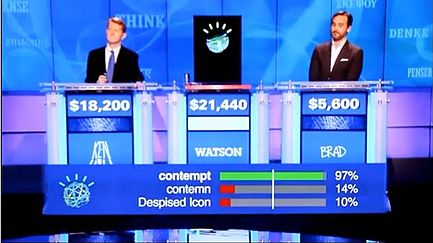
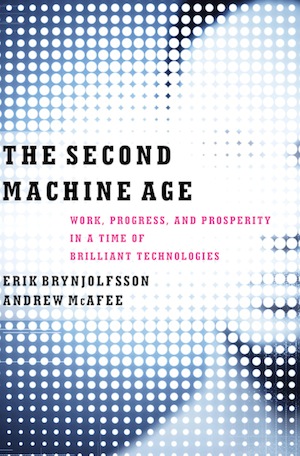
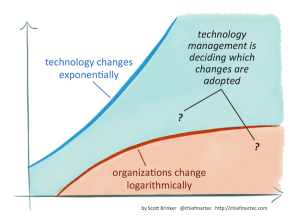

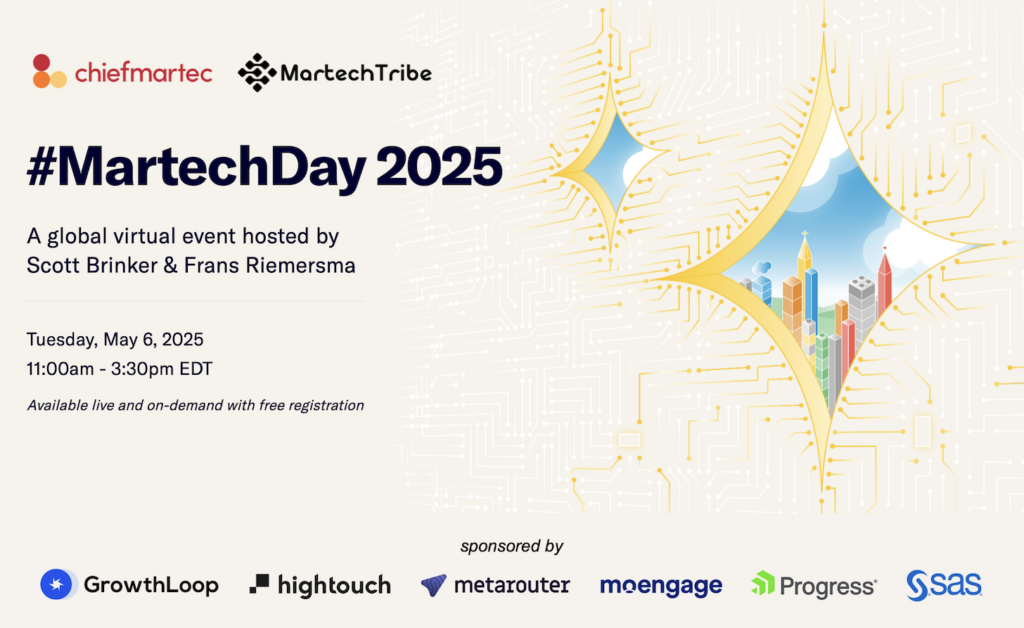
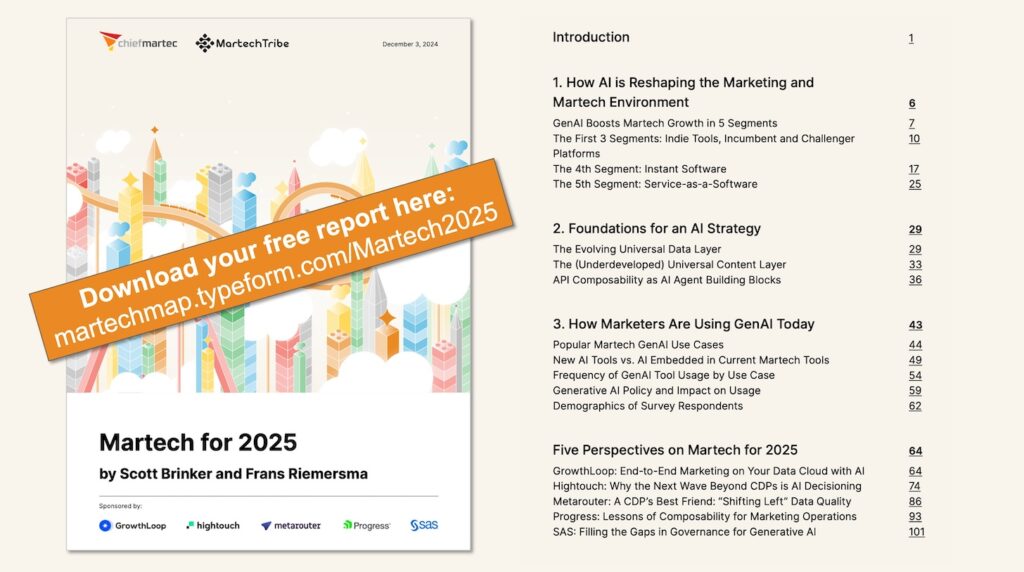

I agree with you Scott. It’s an interesting time, and it’s always hard to grasp the exponential increase as we tend to think linearly.
I see a some big shifts towards “contextual” and “moment” based marketing technologies. One’s that combine consumer social, location, and sensor (smart phone sensors for example) data with big data analytics. What’s your thoughts on contextual marketing technology being created in the next 5-10 years?
I think contextual marketing is a great example of the kind of “science fiction”-like capability that this explosion in computing power will make more feasible. The mass arrival of sensors and the long-awaited Internet of Things seems inevitable in the next couple of years.
The basic concepts of machine learning haven’t changed much, but the data and horsepower on which they can operate are taking big leaps forward. Combined with a bit of “coinvention” in how we tap that power, it feels like we will see some amazing contextual marketing applications arise. And I suspect it won’t even take 5 years.
Yeah I can see some interesting combinations with things like Bitcoin – and the services that make it easy like Coinbase. Micro-payments for both the consumers actions, and businesses gaining access to these moments. Kind of like how people bid on search results with ad-words, but people will bid on moments instead.
What’s the most promising contextual technology for marketing you know of out there?
I don’t think I could narrow down one — the field still seems quite early and highly in flux. But I think “Google Now” does a pretty good job of pointing towards what’s possible.
Thanks for this post, Scott. Very intriguing. I’ve been telling people about how different our world will be in just a few years, about how changes are indeed happening exponentially. To try to get the point across, I find myself talking about the Singularity movement. That usually blows them away.
Last week, a light went on in my head about what will fuel these changes. I was at a marketing/IT conference put on by Neustar. One of the speakers was Chetan Sharma, who talked about how mobile messaging revenues have dried up, and that data access revenues will be drying up as well, which is requiring the mobile/tech firms to find new revenue streams. Sharma’s point was that we are beginning to see the 4th wave of mobile: digital lifestyle providers in different verticals. He talked about how the mobile/tech companies like AT&T, Verizon, and Telefonica are now investing heavily in the 4th wave verticals that encompass health, home, commerce, and industrial automation. Follow the money. It’s what’s going to make happen what the book and your post talk about. What an exciting time.